Summary of Damien Hirst
One of the late-20th century's greatest provocateurs and a polarizing figure in recent art history, Damien Hirst was the art superstar of the 1990s. As a young and virtually unknown artist, Hirst climbed far and fast, thanks to Charles Saatchi, an advertising tycoon who saw promise in Hirst's rotting animal corpses, and gave him a virtually unlimited budget to continue. His shark suspended in a tank of formaldehyde, entitled The Physical Impossibility of Death in the Mind of Someone Living, wowed and repulsed audiences in 1991. In 1995 (the same year that he won the coveted Turner Prize) Hirst's installation of a rotting bull and cow was banned from New York by public health officials who feared "vomiting among the visitors." Hirst, the Sid Vicious of the art world (the Sex Pistols were his favorite band), is the logical outcome of a process of ultra-commodification and celebrity that began with Andy Warhol.
Accomplishments
- From the outset of his career, Hirst devised a fool-proof strategy for grabbing the attention of the public and critics. Rotting corpses appalled and attracted museum visitors, who saw it as a kind of dare. Critics were equally appalled, not so much by the art as by the sky-high prices (often prearranged) paid for it. This kept Hirst at the center of the art world and augmented the value of his work, which continues to command some of the highest prices on the market.
- Bloody bodies (martyrs and the death of Christ) and mothers and children (the Madonna and Child) are iconic themes in Western religious painting. Hirst, who was raised Catholic, cites this as an important dimension of his aesthetic sensibility.
- Controversial as it is, Hirst's approach is firmly rooted in historical and contemporary sources. In its focus on death, it hearkens back to the Memento Mori (reminders of mortality) images in European still life. In using biological materials, he joins other contemporary artists of the late-20th century, among them Robert Rauschenberg, with his taxidermied animals, Carolee Schneemann, who covered herself in raw meat, and Joseph Beuys, who constructed Fat Chair and other sculptures made of fat. Where Hirst differs from his historical and contemporary predecessors is in his display of entire corpses as visual spectacles.
- Hirst is a great showman. One needn't be an art specialist to appreciate the thrill of seeing a dead shark up close. Not just for art world insiders, these strike a chord with many first-time visitors to museums, introducing them to the challenges of contemporary art in an engaging and immediate way.
- Love him or hate him, Hirst was a visionary in anticipating the needs of the contemporary art market. One could argue, as some have, that this in itself is a form of art.
The Life of Damien Hirst
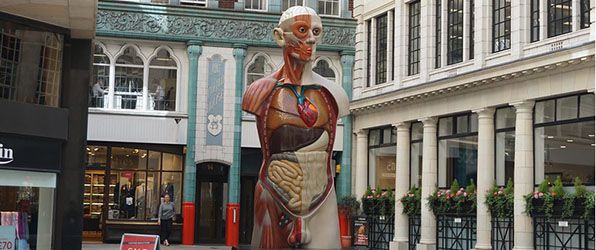
Hirst specializes in taking on life and death, in what is underneath the surface. As one of the world’s most famous artists, his visions are on public display.
Important Art by Damien Hirst
With Dead Head
The artist, with a huge grin on his face, poses next to a severed head in a morgue. Hirst selected the photograph and enlarged it in 1991 for one of his early solo shows, though it had been taken several years earlier. He said of the photograph, "I wanted to show my friends, but I couldn't take all my friends there, to the morgue in Leeds. I'm absolutely terrified. I'm grinning, but I'm expecting the eyes to open and for it to go: 'Grrrrraaaaagh!'"
This early piece, indicative of his preoccupation with the relationship between life and death, is gruesome, satirical, and disturbing, evoking the conflicting feelings of repulsion and fascination many feel when confronted with the physical realities of death. In this way, Hirst's work returns us to the tradition of 17th-century Cabinets of Curiosities (specimens from the natural world, including parts of cadavers, arranged for public display), and acknowledges the eternal appeal of disturbing, even repulsive biological subjects.
Black and white photograph on paper - Collection of the Tate, United Kingdom
In and Out of Love (White Paintings and Live Butterflies)
Hirst's first solo exhibition, held in London in 1991, built upon his established reputation for using live animals in his work. The artist glued pupa onto white canvases, where they hatched into butterflies, fed on bowls of fruit, mated, and subsequently died. When asked what the work was about, he responded, "love and realism, dreams, ideals, symbols, life and death", and also "the way ... the symbol exists apart from the real thing. Or the butterflies still being beautiful even when dead." He admitted it was, "a crazy thing to do when in the end it's all art." The previous year, Hirst had displayed a significantly gorier work entitled A Thousand Years (1990), a glass case with maggots feeding off a bloody cow's head, which attracted the attention of Charles Saatchi, who would become his most important financial backer. While A Thousand Years had solidified his reputation, Hirst and his investor perhaps intuited that the public was not yet ready for such a work.
Hirst revisited the theme of butterflies in an installation at the Tate Modern in 2012. Two windowless rooms were filled with live butterflies, brought in daily by the butterfly expert from London's Natural History Museum and swept up by the museum staff when they perished. While some viewers were distressed that the butterflies were not in their natural habitat (animal rights activists were not amused), others appreciated the opportunity to contemplate the fragility of life. As one viewer commented, "There's a terrific poignancy about them because their lifecycle is so short and they are vulnerable and delicate."
Installation - Yale Center for British Art, New Haven, Connecticut
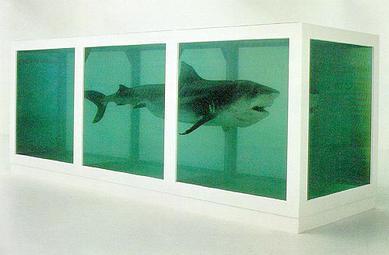
The Physical Impossibility of Death in the Mind of Someone Living
This is the work that established Hirst as a major presence in the art world. A little like the art world version of Jaws, this installation featuring a 14-foot tiger shark preserved in formaldehyde that capitalizes on the viewer's visceral response, a spine-tingling thrill one experiences in the presence of a good horror movie, knowing one is safely removed from the danger. The Physical Impossibility of Death in the Mind of Someone Living was among the works showcased in the Sensation exhibition of the early 1990s, the great succes de scandale" of the late-20th century and a game-changer in the art world. Charles Saatchi funded both the work and the exhibition, which were roundly condemned by art world conservatives from London to New York, and embraced by audiences eager for something new. On the meaning of the work, Hirst commented that the vitrines "first came from a fear of everything in life being so fragile" and explained that he wanted "to make a sculpture where the fragility was encased... [and] exists in its own space." Jeff Koons's Total Equilibrium Tanks (1985), a basketball suspended in a glass case, is an obvious precedent for Hirst's work. Dismissed by some critics as a "pickled shark," this has nevertheless come to be considered an icon of British art in the 1990s. Due to deterioration of the original specimen, the shark was replaced in 2006.
Tiger shark, formaldehyde solution, glass, steel - The Metropolitan Museum of Art, New York
Abalone Acetone Powder
Since 1988, Hirst has been generating so-called "spot paintings", also known as The Pharmaceutical Paintings. This series are his most recognizable and iconic works, aside from his animal sculptures. No one knows how many there are, but estimates are in the thousands. While the artist painted the earliest ones, later spot paintings continue to be produced by assistants under his direction, sparking questions about value.
The cheerful impact of these canvases might at first seem at odds with Hirst's preoccupation with mortality. In fact, they are very much in keeping with it. Each of Hirst's dot compositions mimics the molecular structure of an addictive, potentially lethal substance that cannot be accessed without a doctor's consent. These paintings thus constitute a witty, withering comment on a multi-billion dollar pharmaceutical industry that dispenses drugs like candy.
They are also a nod to earlier colorists Hirst admires, among them Gerhard Richter and Mark Rothko. Hirst says, "I was always a colorist ... I just move color around on its own. So that's what the spot paintings came from - to create that structure to do those colors, and do nothing. I suddenly got what I wanted. It was just a way of pinning down the joy of color."
Paint on Canvas - Damien Hirst and Science Ltd
Pharmacy
First on display at the Cohen gallery in 1992 and now permanently on view the Tate Modern, this installation is a detailed replica of a pharmacy. The work is related to the spot paintings, named after pharmaceuticals, but the impact is strikingly different. According to the artist, this work was inspired by walking into a pharmacy and marveling at its ability "to provoke an idea of confidence." The faux pharmacy, as the artist is fully aware, thwarts the expected experience of confidence in this familiar space, and creates a kind of free-floating anxiety. With all the trappings and none of the personnel, the space seems potentially sinister. An additional dimension of the original installation in 1992 enhanced this effect. Holes bored into the walls allowed insects to enter and feed off honeycomb placed around the room. They then flew toward the light and were zapped by the insectocuter. Their performance was a metaphor for the inevitability of death - the end at which we all arrive at some point, and the ultimate futility of modern medicine's efforts to prevent it.
Glass, faced particleboard, painted MDF, beech, ramin, wooden dowels, aluminum, pharmaceutical packaging, desks, office chairs, foot stools, apothecary bottles, colored water, insect-o-cutor, medical text books, stationery, bowls, resin, honey, and honeycomb - Collection of the Tate, United Kingdom
Mother and Child (Divided)
This floor-based sculpture is comprised of four glass tanks, each of which contains one bisected half of a cow and calf. The white wood frames on each tank evoke the pure, clean lines of classic Minimalist sculpture. Their contents, however, are neither clean nor minimalist. Each animal is suspended above the base of the tank, its front legs dangling limply, deepening the sense of lifelessness. The tongue of the calf lolls out of its mouth. The tanks are installed in pairs, the calf in front of the mother, with space between each pair allowing a visitor to walk directly along the inside of each animal as if through a hallway, observing the pale and intricate internal organs and skeletal structure on either side. The effect is, to say the least, disconcerting, turning a sacred theme in art - that of the mother and child - into a ghastly, graphic, literal dissection. Presented at the Venice Biennale, this was Hirst's international debut. The influence of Francis Bacon, Hirst's friend and major supporter, is apparent in the choice of subject and unflinching attention to gory detail.
In focusing on the physical consequences of death, the piece hearkens back to another time-honored theme in western art, that of the memento mori, a class of images devoted to reminding viewers of the inevitability of death and the immortality of the soul. Hirst's work has both these qualities. While certainly a reminder of death, the bodies are suspended in a substance that makes them weightless. When seen from the side, the dissection is invisible and the mother and child seem to ascend side-by-side in profile. As in all of Hirst's installations, the effect of the sculpture is dependent upon the viewer's presence in the space and ability to walk around it.
Cow, calf, formaldehyde solution, glass, steel, perspex, and acrylic paint - Collection of the Tate, United Kingdom
Aubade, Crown of Glory
Since the very beginning of his career, winged insects have played a prominent role in Hirst's work. For the past decade, he has focused heavily on butterflies, both as symbols and literal materials. This canvas, equivalent to a large stained glass window (roughly 8 by 10 feet) in size and dimensions, is comprised of thousands of brilliantly hued butterflies. The form literally reaches heavenward, evoking religious iconography.
Butterflies, traditionally a symbol of the resurrection of Christ, assume a broader significance in Hirst's work, where they are emblematic of ascendance, a theme also found in the animal installations, where bodies seem suspended in midair. Hirst's preserved corpses heighten our awareness of the fleeting nature of life and the possibility of something beyond it. By placing beauty front and center, the work departs from the overtly gruesome presentation of Hirst's more controversial early works, but retains many of its basic methods and themes.
Butterflies and household gloss on canvas - Gagosian Gallery
For the Love of God
This sculpture consists of an 18th-century human skull recreated in platinum and encrusted with 8,000 diamonds. According to the New York Times, it was inspired by an exasperated comment from Hirst's mother about his work: "for the love of God, what are you going to do next?" The skull, a symbol of mortality, fits within a long tradition of such reminders. Like virtually all of Hirst's other major works, it ignited intense controversy. The astronomical cost of the materials involved (?15 million) and asking price of ?50 million were considered outrageous. The press eventually revealed that Hirst was among the anonymous bidders for the object, sparking outcry that the piece was nothing more than a publicity stunt. Whether or not this was the artist's original intention, the work brought to light important questions about the astronomically inflated prices of art on the contemporary market. Strange as it may sound, a work that had cost only a few thousand dollars would not be as successful or as interesting as this one. Hirst's brilliance as an artist is inseparable from the publicity surrounding his work; this is literally part of the art.
Platinum, diamond, human teeth - Private Collection
Biography of Damien Hirst
Childhood
Damien Hirst was born in Bristol, England in 1965. His family moved to Leeds shortly after he was born, where he spent much of his childhood. After his parents separated when he was 12, he was raised exclusively by his mother. A rebellious teen, he was arrested twice for shoplifting and was not a strong student, however he showed promise in art, and eventually decided to study at university. Coming of age in the late 1970s and early 1980s, Hirst took a keen interest in the punk music and social scene that was taking hold within British culture, gravitating toward its rejection of tradition and confrontational, gritty subject matter. He was a particular fan of the Sex Pistols - even though his mother once melted one of their LP's into a fruit bowl - and would reference them numerous times in his later work.
Early Training
Hirst pursued a B.A. in Fine Art at Goldsmiths, University of London from 1986 to 1989, though his application was rejected the first time he applied. He became intensely absorbed in his studies, and quickly became a prominent member of the student community at Goldsmiths, participating in numerous clubs and organizing student-run events. During his summer breaks, he worked part-time at a mortuary back home in Leeds, an experience that would strongly influence the themes and materials he later utilized as an artist. He occasionally drew specimens and cadavers (a traditional practice among artists in the west) and the job also provided him with the technical knowledge he would later use to transform biological specimens into sculptures.
During his second year at Goldsmiths, he was the lead organizer of a group exhibition called Freeze. The show would mark a turning point in his career. In addition to his own work, the show featured pieces by sixteen fellow students, including Fiona Rae, Sarah Lucas, and other emerging talents in postmodernist art. As a group, they would become known for their take-no-prisoners approach to art, employing shockingly unconventional materials and introducing concepts that challenged the definition of art.
Freeze was held in an inexpensive warehouse space in London's Docklands, then an unfashionable and far-flung neighborhood. Hirst had initially approached a number of commercial galleries, but found little interest in the project. Michael Craig-Martin, one of Hirst's professors, persuaded a number of influential people in the British art scene to attend the show. These included Norman Rosenthal of the British Academy, Nicholas Serota, director of the Tate museums and galleries, and Charles Saatchi, then-owner of the world's largest advertising firm who ran his own London gallery. Freeze and Hirst's subsequent warehouse shows helped to inspire Saatchi to sell off much of his significant collection of contemporary American art and invest in the new generation of British artists. He hunted down pieces from student shows and alternative gallery spaces, culminating in a series of exhibitions throughout the 1990s with the title Young British Artists. Saatchi's nomenclature would stick to Hirst and his peers, who are often still referred to as "the Young British Artists," or YBAs, despite many now being in their 40s and 50s.
Mature Period
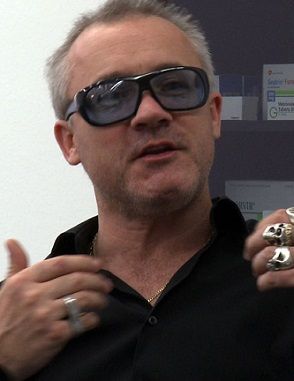
In 1991, Saatchi became Hirst's patron, offering to fund whatever the artist chose to produce. The arrangement between the two men was quick to bear fruit. Saatchi's first Young British Artists show in 1992 brought Hirst international attention and acclaim. His first Saatchi-funded work was titled The Physical Impossibility of Death in the Mind of Someone Living, a large installation piece featuring a preserved tiger shark in a large glass case. The piece earned Hirst a nomination for the Turner Prize, given to contemporary British artists under 50. Although he did not win, he would eventually claim the award in 1995. Almost immediately, he established himself as a divisive and controversial figure in the contemporary art world. His sculptures of preserved, dead animals have been his most famous and hotly debated pieces. For instance, in 1995, Two Fucking and Two Watching, a piece featuring a rotting cow and bull, was banned by New York public health officials, who feared "vomiting among the visitors." He continued to pursue shocking and challenging projects that provoked passionate, love-hate reactions from the art world. He took inspiration from his stint at the morgue, and also cited Francis Bacon - a British painter known for his unflinching, even gruesome depictions of torture, despair, and disfigurement - as a major influence. Bacon, in turn, viewed the installation and rhapsodized about it in a letter to his friend. He would become one of Hirst's major supporters.
By the late 1990s, Hirst had become a key figure in British art and culture. He directed the music video for "Country House" by the hugely popular band Blur, and wrote and directed a short film starring comedian Eddie Izzard. His lofty status within contemporary British art was cemented by 1997's Sensation show at London's Royal Academy, an event which critics have since regarded as the formal acceptance of the YBAs into the mainstream.
Current Work
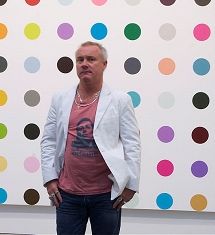
From the late 1990s onward, several of the YBAs became mainstream celebrities in their own right, known for their swagger, swearing, and rock n' roll attitude. Hirst, the Sid Vicious of the bunch, was known for his drunken cocaine binges and outrageous behavior, among them meeting a curator naked, and allegedly removing his pants to insert a chicken bone into his foreskin at a bar in Dublin. As one Guardian reporter noted, "A night out for the Britpack was not really a night out until Hirst had taken down his trousers and waggled his willy in public." Hirst understood that fame and controversy were closely related for him, and played the part well. By the age of 33 (1988) he had written an autobiography, entitled I Want to Spend the Rest of My Life Everywhere, With Everyone, One to One, Always, Forever, Now.
Hirst attracted further controversy when his business relationship with Saatchi ended in 2003. Hirst disapproved of the way Saatchi had exhibited his work at his new gallery space, and was particularly upset that a Mini Cooper decorated in the style of one of his spot paintings was being exhibited as a serious artwork. He pulled all his works from the show, which in turn led Saatchi to call off a major Hirst retrospective at the Tate Modern. The artist decided to end his relationship with his long-time patron, buying back a number of early works for a hefty sum and telling the British press, "I'm not Charles Saatchi's barrel-organ monkey... he only recognizes art with his wallet."
Hirst has had little difficulty finding buyers and audiences for his work since ending his relationship with Saatchi. While recognizing the inherent value of public spectacle, he was savvy enough to know that shock was not sustainable as a style, and though his work continues to be highly polarizing, he adapts and innovates to suit the demands of an audience that expects him to take risks. In September 2008, he took an unprecedented step for a living artist by selling a complete show, Beautiful Inside My Head Forever, exclusively by auction at Sotheby's. It set a world record for the highest proceeds at auction by a living artist, 70.5 million pounds. Even as the global financial markets were crumbling, the auction helped make Hirst one of the richest artists in the world. Still, his work received mixed reviews. In 2009, he exhibited a group of paintings, No Love Lost, Blue Paintings, which provoked the ire of many critics, who labeled the pieces "dull" and "amateurish."
These days, he shows no signs of slowing down. He has become an active member of Britain's culinary scene, funding and designing a number of restaurants, some of which have been more successful than others. He also opened a store called Other Criteria, which produces affordable, limited-edition collector's pieces. In October 2015, he opened the Newport Street Gallery in south London, showcasing his personal collection of over 3,000 works of art.
The Legacy of Damien Hirst
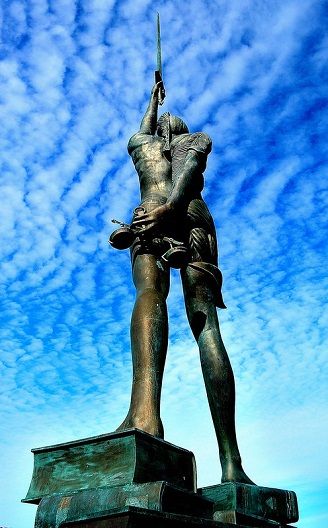
Controversy and success continue to be inseparable for Hirst, raising questions about the relationship between art and money that are unlikely to be resolved any time soon. A shrewd businessman, Hirst has transformed himself into a personal brand. He has something to sell to almost anyone. For patrons who prefer not to live with a dead shark, there are his "spot paintings," easy-to-look-at abstract canvases, based on the molecular structures of controlled pharmaceuticals. Reproductions of the notorious diamond-encrusted skull are available to consumers in an array of prices and sizes. He has also launched his own line of skateboards. In his relentlessly enterprising, unapologetically commercial approach to art, Hirst's career is closely aligned with that of fellow art star Jeff Koons, who has cited him as an influence. Cindy Sherman, Sarah Lucas, and Tracey Emin have also mentioned Hirst's impact on their work. Easily one of the most prominent artists of his generation, Hirst's success - along with that of the other YBAs - helped to create the conditions for the establishment of Tate Modern in 2000, which has since become the most-attended modern art museum in the world.
Hirst continues to be widely criticized by contemporary critics and artists who feel his work is overrated and pretentious. For instance, after his diamond skull (For the Love of God, 2007) originally failed to sell for its £50 million asking price, British artist Laura Keeble created an inexpensive replica and photographed it in the trash outside London's White Cube gallery for a work she titled Forgotten Something? Similarly, in 2009, Spanish artist Eugenio Merino displayed a sculpture of Hirst in a glass case, shooting himself in the head, titled 4 The Love of Go(l)d. Merino, actually a great admirer of Hirst, told The Guardian, "I thought that, given that he thinks so much about money, his next work could be that he shot himself. Like that the value of his work would increase dramatically. Obviously, though, he would not be around to enjoy it." While Merino claims his work is as much tribute as critique, critics have also lambasted Hirst's open desire to cash in on his talent and extensive reliance on assistants in creating his work, particularly his "spot paintings." He is candid about the fact that he did not produce the majority of these paintings, once commenting to an interviewer, "The best person who ever painted spots for me was Rachel [Howard]. She's brilliant. Absolutely f***ing brilliant. The best spot painting you can have by me is one painted by Rachel." His methods and subjects are controversial, but the impact of Hirst's creativity as an artist, curator, and entrepreneur will likely be felt within the art world for many years to come.
Influences and Connections

![Michael Craig-Martin]() Michael Craig-Martin
Michael Craig-Martin
Useful Resources on Damien Hirst
- Damien HirstOur PickBy Ann Gallagher
- Damien Hirst: RelicsOur PickBy Francesco Bonami, Abdellah Karroum, Michael Craig-Martin, and Nicholas Serota
- Damien Hirst: A RetrospectiveBy Nicholas James
- I Want to Spend the Rest of My Life Everywhere, with Everyone, One to One, Always, Forever, NowBy Damien Hirst
- Damien Hirst: On the Way to WorkOur PickBy Damien Hirst
 Ask The Art Story AI
Ask The Art Story AI


























